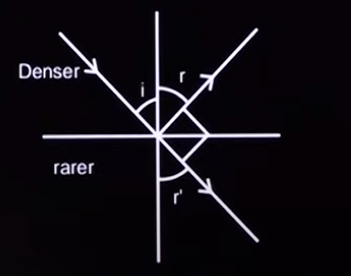Assertion : When a ray of monochromatic light goes from one medium to another the frequency of incident, reflected and refracted rays is same.
Reason : The incident, reflected and refracted rays are coplanar.
If both assertion and reason are true and reason is the correct explanation of assertion .
If both assertion and reason are true but reason is not the correct explanation of assertion .
If assertion is true but reason is false.
If both assertion and reason are false.
The correct Answer is:b
In the case of reflection, the incident ray, the normal nd reflected ray lie in the same plane. In the case of refraction the incident ray the normal and the refracted ray lie in the same plane. Therefore, the incident ray, reflected ray and the refracted ray are coplanar. The frequency of the ray does not change when the light travels from one medium to another.
Similar Questions
A ray of light passes from a denser medium to a rarer medium at an angle of incidence i. The reflected and refracted rays make an angle of 90∘ with each other. The angle of reflection and refraction are resepectively r and r'. The critical angle is given by :

View SolutionA ray incident from denser medium to rarer medium. If angle between reflected ray and refracted ray is 900 then angle angle of reflection r and angle of refraction r' will be respectively.

View Solution
Knowledge Check
Assertion : The frequencies of incident, reflected and refracted beam of monochromatic light are same.
Reason : The incident, reflected and refracted rays are coplanar.AIf both, Assertion and Reason are true and the Reason is the correct explaination of the Assertion.BIf both, Assertion and Reason are true but Reason is not a correct explaination of the Assertion.CIf Assertion is true but the Reason is false.DIf both, Assertion and Reason are false.Assertion : The frequencies of incident, reflected and refracted beam of monochromatic light are same.
Reason : The incident, reflected and refracted rays are coplanar.AIf both assertion and reason are true and reason is the correct explanation of assertion.BIf both assertion and reason are true but reason is not the correct explanation of assertion.CIf assertion is true but reason is false.DIf both assertion and reason are false.Assertion: The frequencies of incident, reflected and refracted beam of monochromatic light incident beam of monochromatic light incident from one medium to another are same
Reason: The incident, reflected and refracted rays are coplanarAAssertion is True, Reason is True, Reason is a correct explantion for AssertionBAssertion is True, Reason is True, Reason is not a correc explanation for AssertionCAssertion is True, Reason is FalseDAssertion is False, Reason is False.
A ray of light-is incident on glass at the polarising angle ip. Find the angle between the reflected and refracted rays.
View SolutionA ray of light-is incident on glass at the polarising angle ip. Find the angle between the reflected and refracted rays.
View SolutionThe angle between incident ray and reflected ray or refracted ray is called _____
View SolutionAssertion : When monochromatic light is incident on a surface separting two media, the reflected and refracted light both have the same frequency as the incident frequency.
Reason: The frequency of monochromatic light depends on media.
View SolutionIf a ray of light in a denser medium strikes a rarer medium at an angle of incidence i, the angles of reflection and refraction are respectively, r and r' If the reflected and refraction rays are at right angles to each other, the critical angle for the given pair of media is
View Solution
